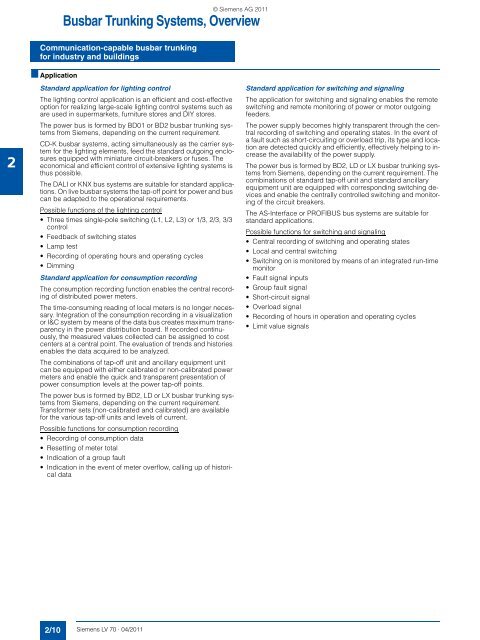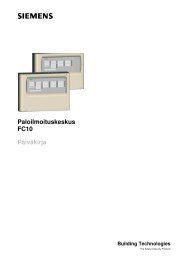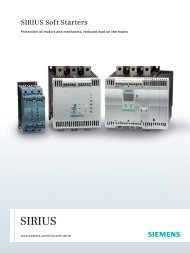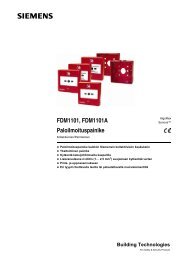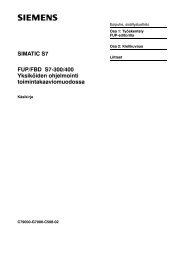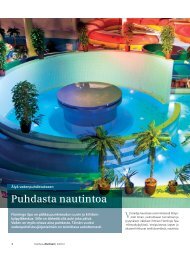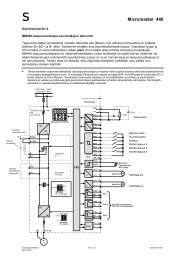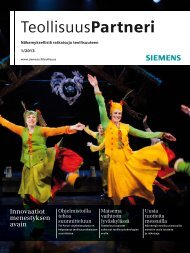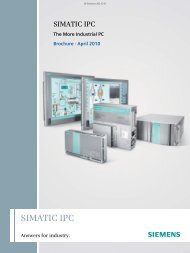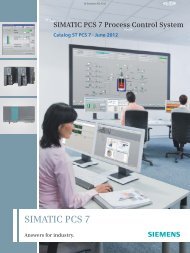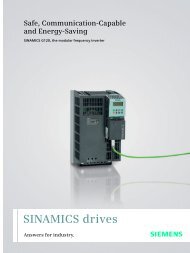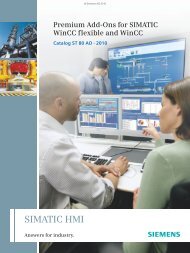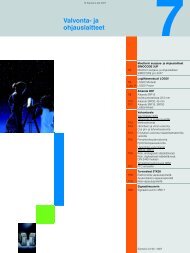Catalog LV 70 2011 - Low & Medium Voltage - Siemens
Catalog LV 70 2011 - Low & Medium Voltage - Siemens
Catalog LV 70 2011 - Low & Medium Voltage - Siemens
You also want an ePaper? Increase the reach of your titles
YUMPU automatically turns print PDFs into web optimized ePapers that Google loves.
© <strong>Siemens</strong> AG <strong>2011</strong><br />
Busbar Trunking Systems, Overview<br />
Communication-capable busbar trunking<br />
for industry and buildings<br />
2<br />
■ Application<br />
Standard application for lighting control<br />
The lighting control application is an efficient and cost-effective<br />
option for realizing large-scale lighting control systems such as<br />
are used in supermarkets, furniture stores and DIY stores.<br />
The power bus is formed by BD01 or BD2 busbar trunking systems<br />
from <strong>Siemens</strong>, depending on the current requirement.<br />
CD-K busbar systems, acting simultaneously as the carrier system<br />
for the lighting elements, feed the standard outgoing enclosures<br />
equipped with miniature circuit-breakers or fuses. The<br />
economical and efficient control of extensive lighting systems is<br />
thus possible.<br />
The DALI or KNX bus systems are suitable for standard applications.<br />
On live busbar systems the tap-off point for power and bus<br />
can be adapted to the operational requirements.<br />
Possible functions of the lighting control<br />
• Three times single-pole switching (L1, L2, L3) or 1/3, 2/3, 3/3<br />
control<br />
• Feedback of switching states<br />
• Lamp test<br />
• Recording of operating hours and operating cycles<br />
• Dimming<br />
Standard application for consumption recording<br />
The consumption recording function enables the central recording<br />
of distributed power meters.<br />
The time-consuming reading of local meters is no longer necessary.<br />
Integration of the consumption recording in a visualization<br />
or I&C system by means of the data bus creates maximum transparency<br />
in the power distribution board. If recorded continuously,<br />
the measured values collected can be assigned to cost<br />
centers at a central point. The evaluation of trends and histories<br />
enables the data acquired to be analyzed.<br />
The combinations of tap-off unit and ancillary equipment unit<br />
can be equipped with either calibrated or non-calibrated power<br />
meters and enable the quick and transparent presentation of<br />
power consumption levels at the power tap-off points.<br />
The power bus is formed by BD2, LD or LX busbar trunking systems<br />
from <strong>Siemens</strong>, depending on the current requirement.<br />
Transformer sets (non-calibrated and calibrated) are available<br />
for the various tap-off units and levels of current.<br />
Possible functions for consumption recording<br />
• Recording of consumption data<br />
• Resetting of meter total<br />
• Indication of a group fault<br />
• Indication in the event of meter overflow, calling up of historical<br />
data<br />
Standard application for switching and signaling<br />
The application for switching and signaling enables the remote<br />
switching and remote monitoring of power or motor outgoing<br />
feeders.<br />
The power supply becomes highly transparent through the central<br />
recording of switching and operating states. In the event of<br />
a fault such as short-circuiting or overload trip, its type and location<br />
are detected quickly and efficiently, effectively helping to increase<br />
the availability of the power supply.<br />
The power bus is formed by BD2, LD or LX busbar trunking systems<br />
from <strong>Siemens</strong>, depending on the current requirement. The<br />
combinations of standard tap-off unit and standard ancillary<br />
equipment unit are equipped with corresponding switching devices<br />
and enable the centrally controlled switching and monitoring<br />
of the circuit breakers.<br />
The AS-Interface or PROFIBUS bus systems are suitable for<br />
standard applications.<br />
Possible functions for switching and signaling<br />
• Central recording of switching and operating states<br />
• Local and central switching<br />
• Switching on is monitored by means of an integrated run-time<br />
monitor<br />
• Fault signal inputs<br />
• Group fault signal<br />
• Short-circuit signal<br />
• Overload signal<br />
• Recording of hours in operation and operating cycles<br />
• Limit value signals<br />
2/10 <strong>Siemens</strong> <strong>LV</strong> <strong>70</strong> · 04/<strong>2011</strong>


